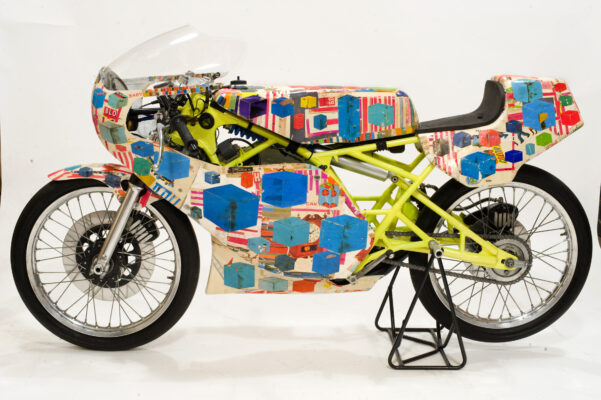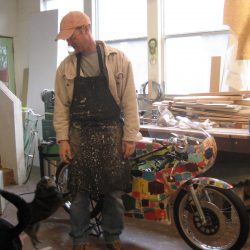The protagonist of Lance Letscher’s recent children’s book asks himself a question: “What is the perfect machine?” It is a question that pervades Letscher’s recent exhibition at D. Berman Gallery, a collection of collage works that also serve to illustrate the book that shares the exhibition’s title The Perfect Machine. Frenetic abstract assemblages in children’s block colors cover the walls of the galleries. Peeking through and behind these more formal geometric abstractions are images of shifts and gears, cut-out ransom note letters, and sections of children’s books from the 1950s and 60s. The works create a tension between the handmade and the machine-driven––the human impulse to create and the mechanical directive to produce.
Letscher is known for taking mundane everyday objects and creating an arrangement of abstract formal beauty. The works exhibit a ruddy geometry as the materials he chooses are often worn down old record covers, the boards of rummage sale books or used magazines. These found items, arranged so meticulously and obsessively by Letscher, recall the best of outsider art. Yet there is no dark underbelly of madness to this work—it is as light and airy as a child’s tale (even a collaged gun looks innocent and banal in this exhibition). The images of gears and shifts that radiate out of the pieced together cardboard squares aren’t referencing the mechanization of society a la Hannah Höch, but rather merely exist as the very things that they are—the inside stuff that makes a machine run.
The works in the exhibition, some larger and looser with scribbles and roughed up empty space, some smaller and denser with a flurry of letters, images and color, stand perfectly well on their own. However, combined with the narrative of the young boy “whose head was filled with ideas” and who wonders “Could a tree be a machine?” the works elucidate a deeper connection between the mechanical and human. Throughout the tale, the boy examines different types of machines: a walking machine, a city with wheels, a gun, a windmill. In the end, the boy wakes from a dream and asks, “What can write a book or paint a picture? Can’t I do all these things?”
It’s a sweet tale of self-discovery, the realization that machines, like picture books and collaged images, are also human made. The perfect machine is revealed to be the imperfect human. Is this message too sweet? Are the works depleted of a richer, more complex reading due to their association to a child’s book? Perhaps. I certainly would like to see what happens when the machine/human goes awry. Does the gun ever go off accidentally? What happens when the train goes off the rails? The works, at times, can feel sterile; frenetic without any real movement. A more pressing question might not be “What is the perfect machine?” but instead, “Can the perfect machine make compelling art?”
Katie Geha is pursuing her Ph.D. in art history at The University of Texas at Austin.


